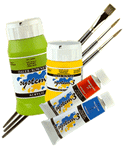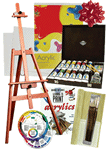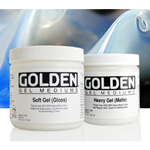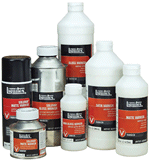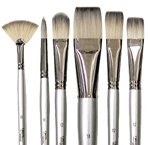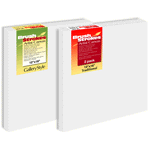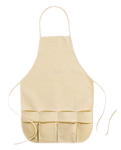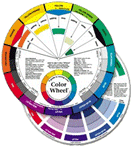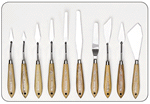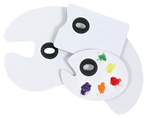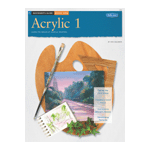FINAL REMOVEABLE VARNISHES
SOLUVAR REMOVABLE VARNISHES
SOLUVAR GLOSS
- Apply as a final gloss varnish over dry acrylic or oil paint.
- Increases the depth and intensity of color.
- May be mixed with Soluvar Matte Final Picture Varnish for a semi-gloss sheen.
SOLUVAR MATTE
- Apply as a final matte varnish over dry acrylic or oil paint.
- Lowers intensity and depth of color, while reducing the surface glare.
- May be mixed with Soluvar Gloss Final Picture Varnish for a semi-gloss sheen.
Attributes - Soluvar Varnish
- Available in Gloss and Matte which may be intermixed for a variety of sheens.
- Permanent, removable, final varnish for acrylic and oil paintings that protects painting surface and allows for removal of surface dirt, without damaging painting underneath. Once surface is clean, a new coat of Soluvar may be reapplied to surface.
- Thin with mineral spirits or turpentine. Do not use Odorless Mineral Spirits.
- Dries to a clear, non-tacky, water resistant, hard film that is resistant to retention of dirt and prevents dirt and pollutants from contacting paint surface.
- Self-leveling. Will not hold brushstrokes.
- Flexible. Will not crack as surface expands and contracts during temperature and humidity changes.
- Resists discoloring (non-yellowing, nonfogging) due to humidity, heat and ultraviolet light.
- Contain ultraviolet light inhibitors that resist color fading by diffusing UV radiation before it comes in contact with painted surface. The thicker the varnish film, the greater the protection.
APPLICATION - ALL VARNISHES
Brush and Paint Pad Application
- Use a wide, soft hair brush or paint pad (vacuum pad prior to use to remove lint). Size of area to be varnished will determine the size of the applicator. The smaller the surface area, the narrower the brush. Generally, a 14" flat brush is used.
- Apply varnish in 1-3 thin coats, rather than 1 thick coat. A thick coat will take longer to dry, may dry cloudy, may drip or sag during application and has a greater chance of showing brush strokes when dry.
- Horizontal surface application is best with less chance of varnish running. After varnishing, the surface should be shielded with a protective "tent". This will prevent any dust or air borne particles from settling into varnish as it dries.
- Apply varnish in slightly overlapping pattern that covers entire artwork. Apply in horizontal and vertical brush strokes, so that entire area is evenly coated.
- Do not rework areas you might miss as the brush could pick up partially dried varnish and cause clouding. If areas are missed, wait until the varnish is dry and apply another coat.
- When applying Liquitex Permanent Matte Varnish or Satin Permanent Varnish, apply no more than 1-2 thin coats. A thick application may result in cloudiness when dry. If more than 2 coats are desired, first varnish with Gloss Medium & Varnish until desired thickness is achieved, then final varnish with matte or satin varnish.
Spray Application
Refer to Part II Applications& Techniques:Airbrush for more detailed information.
- Most even application method.
- Use for textured surfaces (thick impasto, thick textures), where brush application may result in foaming and fragile surfaces (watercolor, tempera, graphite, pastel, gouache), where brush application may disrupt drawing or painted surface.
Use
- Select air pressure (PSI) depending on air gun used and viscosity of varnish. Greater PSI permits thicker varnish to be sprayed, but may affect fragile surfaces.
- 2-3 light coats are better than 1 thick coat.
- Spray a continuous film by moving the spray gun in a smooth motion from one side of the painting to the other. First coat horizontal, second coat, third coat horizontal, etc.
- During spray application maintain same distance across the surface of the artwork. Move your body as well as your arm to avoid "arching" motion and uneven application.
APPLICATION - SPECIFIC VARNISHES
LIQUITEX PERMANENT NON-REMOVABLE VARNISHES
All Varnishes Except Soluvar
- Apply as a final varnish over dry acrylic paint.
- Varnish surface and environment must be clean, dry and dust free.
- Acrylic paintings must be completely dried and cured 48-72 hours before varnishing.
- Application may be done by brush or spray. Generally a sprayed application will be thinner, smoother and more even. Rolling or sponging application is not recommended.
- Caution: Acrylic paints and mediums become increasingly brittle in cold weather. Do not apply below 600F.
Matte and Satin Permanent Varnish
- Apply 1-2 coats of Liquitex Gloss Medium & Varnish before applying Liquitex Matte Varnish. This seals the surface and prevents the varnish solvent in the matte varnish from sinking into the surface. A frosted or cloudy appearance can result from the matting agent being deposited on the surface.
LIQUITEX SOLUVAR FINAL REMOVABLE PICTURE VARNISHES
- Apply as a final varnish over dry acrylic or oil paint.
- Application may be done by brush or spray. Generally a sprayed application will be thinner, smoother and more even. Rolling or sponging application is not recommended. Painting surface and environment must be clean, dry and dust free. Allow oil paint to dry for 6 months to one year and acrylic paint for
- 48-72 hours. Thickness of application will determine exact length of time.
- Varnish may become non-removable if applied over a painting that has not completely dried and cured. If an oil painting is not dry before it is sealed with a varnish, the result may be long-term problems such as cracking or blistering.
- Intermix Gloss and Matte Soluvar Varnish for a variety of sheens. Soluvar Matte Varnish contains matting agents that settle during storage. Gently stir with brush handle or dowel until completely re-dissolved. Do not shake.
- Apply 1-2 layers of Soluvar Varnish. Let dry
- 24 hours between coats.
- Over Acrylic Paint
- Allow acrylic paintings to dry for 48-72 hours or longer if paint is very thick.
- Apply 1-2 coats of Gloss Medium & Varnish as an isolation barrier. The barrier coat physically separates the painting from the Soluvar Varnish and seals surface. This aids in a more even application of Soluvar Varnish and protects the painting, if the Soluvar Varnish needs to be removed. Allow to dry for 3 days.
- To insure proper adhesion, surface must be cleaned with lint free rag dampened with mineral spirits.
- Apply 1-2 layers of Soluvar Varnish. Let dry 24 hours between coats.
THINNING - ALL VARNISHES
- Thinning increases penetration and can make it easier to apply varnish.
- Over thinning may result in weak varnish film. poor adhesion, running and soaking into substrate.
THINNING - SPECIFIC VARNISHES
Permanent Flexible Surface Varnishes
- Thin, if desired, with a small amount of water to allow the varnish to flow easily from the brush or airbrush.
- Thin with small amount of Flow-Aid water to reduce brush marks or spray apply. Refer to Liquitex Paint Additives: Flow-Aid Flow Enhancer.
High Gloss or Satin Permanent Rigid Surface Varnishes
- Do not thin as it will weaken the varnish film and adhesion.
Soluvar Gloss & Matte Final Removable Picture Varnishes
- Thin with up to 25% mineral spirits or turpentine. Do not use Odorless Mineral Spirits.
VARNISH REMOVAL
Liquitex Permanent Non-RemovablenVarnishes
(ALL Liquitex Varnishes except for Soluvar)
- Not removable. Do not attempt to remove these varnishes with harsh solvents.
Soluvar Gloss and Matte Removable Final Picture Varnish
- Remove varnish in clean, well-ventilated area.
- Wear a dual filter respirator (NIOSH approved) and neoprene gloves. Dampen a small piece of lint free, soft, white cloth with mineral spirits (not "odorless") or turpentine nothing stronger. Do not use ketones or paint removers.
- Work horizontally. Apply mineral spirits generously and allow it to lay on surface for 15-30 minutes. Check periodically. Longer time may be necessary, depending upon age of artwork and strength of mineral spirits. If varnish is not dissolving or dissolving slowly, use a higher strength mineral spirits or turpentine (cover with plastic to slow down evaporation of mineral spirits). Stronger mineral spirits are not labeled as such, but have a stronger odor.
- Rub cloth gently over a small area 1-2 square inches until varnish starts to dissolve.
- Using a clean cloth and clean solvent, rub the area again to remove residue. Repeat this procedure for the entire area to be cleaned. If any paint color shows on the cloth, stop immediately and allow the surface to dry.
- Allow painting to dry before reapplying a fresh coat of Soluvar Final Picture Varnish.


